Market Overview
The Global Carbon Composite Market is predicted to be valued at USD 25.4 billion in 2025 and is expected to grow to USD 48.6 billion by 2034, registering a compound annual growth rate (CAGR) of 7.5% from 2025 to 2034.
Carbon composites are advanced materials made from carbon fibers embedded in a polymer matrix, typically epoxy resin. These fibers offer high strength and stiffness while maintaining a lightweight profile. Carbon composites are known for their excellent strength-to-weight ratio, corrosion resistance, and durability. They are widely used in aerospace, automotive, sports equipment, and high-performance applications. The fibers can be woven or aligned in specific directions to enhance mechanical properties.
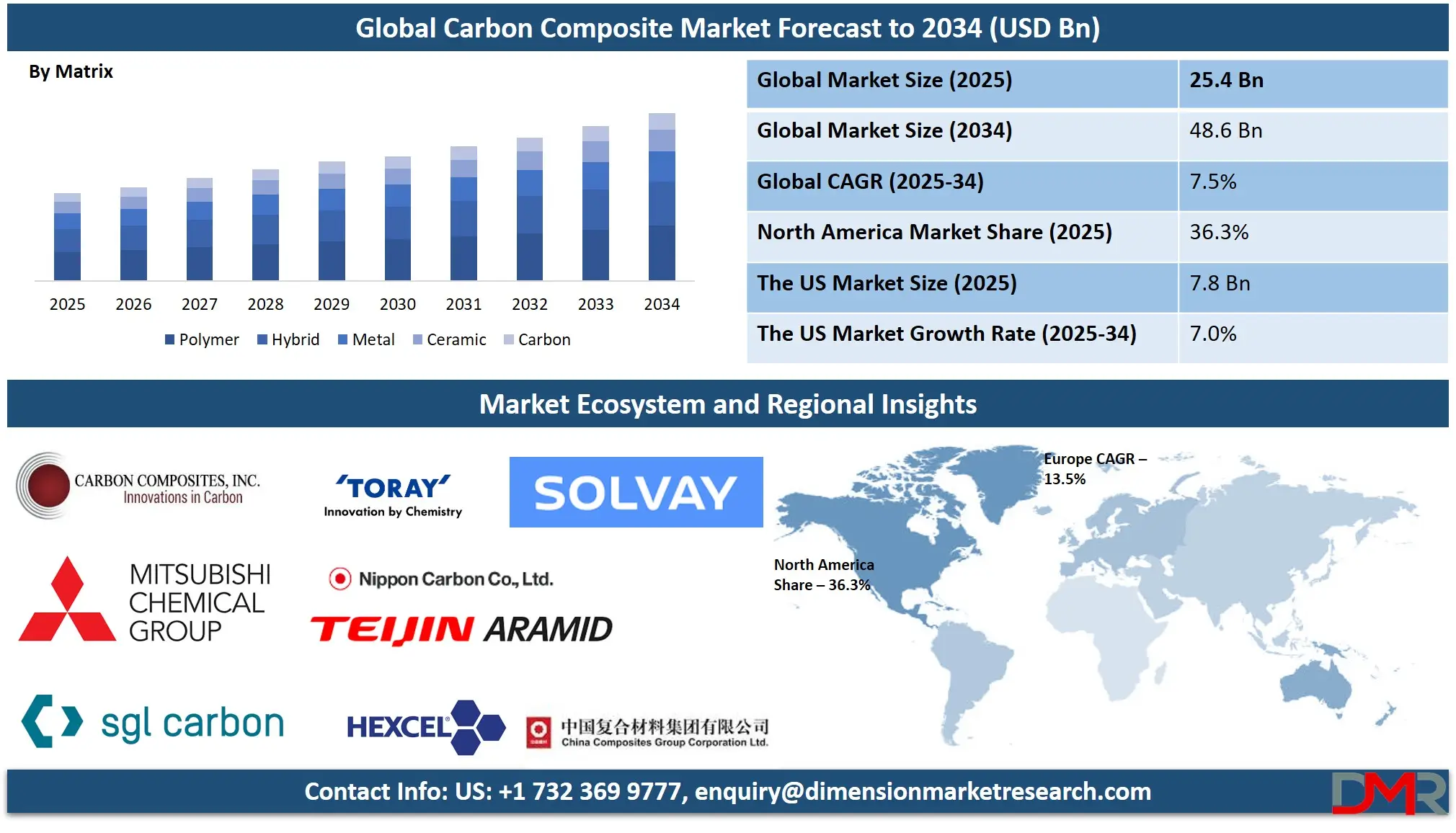
Although expensive, carbon composites offer superior performance compared to traditional metals. Their design flexibility enables innovative engineering solutions, making them a popular choice in industries that demand strength, efficiency, and reduced weight.
Carbon composites have experienced tremendous growth due to their increasing application across a wide variety of high-performance industries such as aerospace and defense, automotive and wind energy. Carbon composites excel at offering exceptional strength with minimal weight, offering enhanced fuel efficiency while simultaneously improving durability - qualities carbon composites excel at offering. Aerospace applications especially can take advantage of its superior physical properties including stiffness-to-weight ratio, thermal expansion rate control and corrosion resistance which make carbon composites suitable components that improve fuel economy as well as performance overall.
Carbon composites are lightweight yet extremely strong materials composed of carbon fibers combined with polyester resin matrix to form lightweight yet strong material. Their light nature enables manufacturers to make components with improved mechanical and thermal properties while using less material and emissions; and as sustainability becomes an increasing global concern, lightweight carbon composites present invaluable opportunities to decrease carbon footprint.
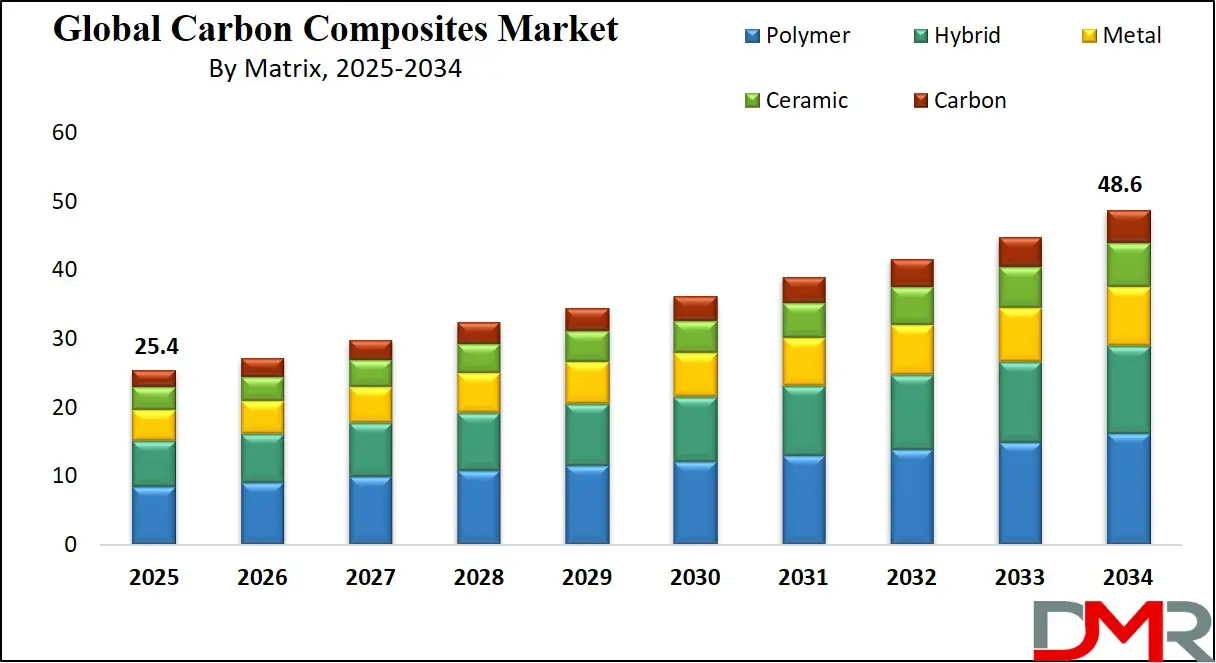
Carbon composites have quickly gained favor across numerous industries, from electric and hybrid vehicles to wind energy applications such as longer turbine blades. Thanks to innovations in material science as well as increased emphasis on efficiency and performance, the carbon composites market could experience substantial expansion, presenting ample opportunity for innovation and investment.
The US Carbon Composites Market
The US Carbon Composite market is projected to be valued at USD 7.8 billion in 2025. It is expected to witness subsequent growth in the upcoming period as it holds USD 14.3 billion in 2034 at a CAGR of 7.0%.
The U.S. carbon composites market is primarily driven by the aerospace and defense sector's demand for lightweight, high-strength materials to enhance fuel efficiency and performance. The automotive industry's focus on fuel-efficient vehicles also contributes significantly. Additionally, the wind energy sector's need for durable materials for turbine blades supports market growth. Technological advancements in manufacturing processes further enable cost-effective production, expanding applications across various industries.
Advanced manufacturing technologies such as automated fiber placement and 3D printing are improving production speed and lowering costs. Sustainability is another major trend, with increasing efforts to develop recyclable and bio-based carbon fibers. These innovations support eco-friendly practices while maintaining high material performance. The combination of technological progress and sustainability efforts is opening new avenues for carbon composites in various industries.
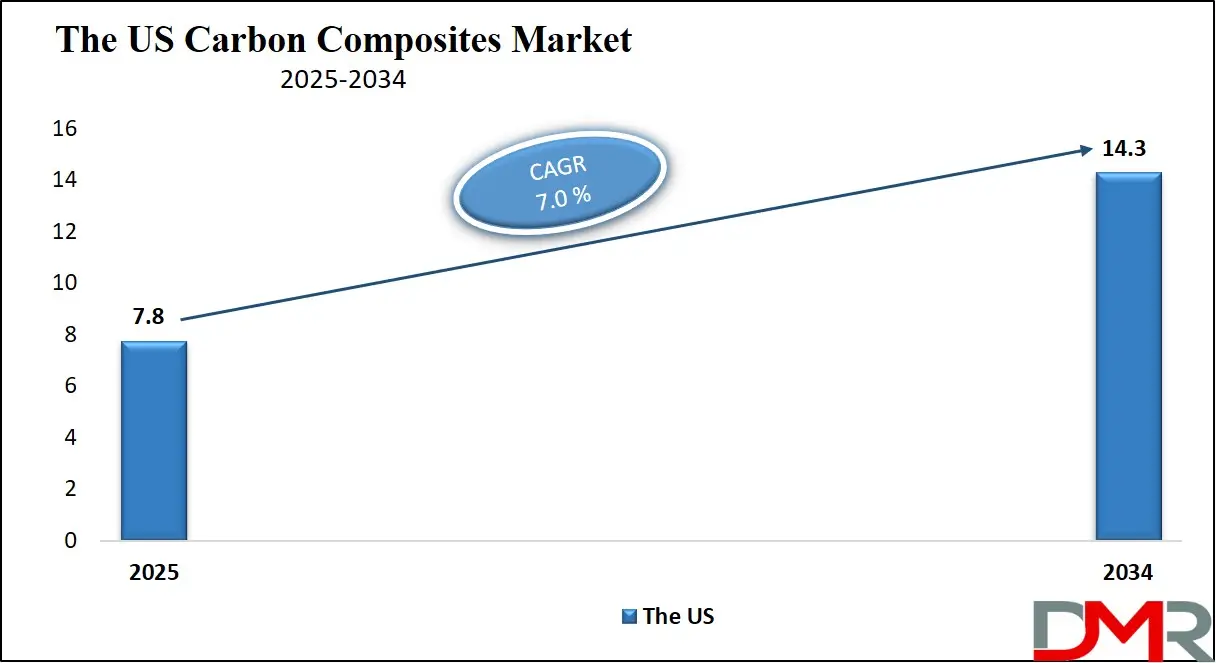
Carbon Composites Market: Key Takeaways
- Market Overview: The global carbon composite market is projected to grow from USD 25.4 billion in 2025 to USD 48.6 billion by 2034, registering a compound annual growth rate (CAGR) of 7.5% during the forecast period.
- US Market Overview: In the United States, the carbon composite market is expected to reach USD 7.8 billion in 2025 and grow to USD 14.3 billion by 2034, with a CAGR of 7.0%.
- Matrix Analysis: Polymers are anticipated to dominate the carbon composites market with a revenue share of 75.3% by the end of 2025. This is due to their lightweight properties, corrosion resistance, and ease of processing, making them ideal for use across aerospace, automotive, and construction industries.
- Process Analysis: The wet lamination and infusion process is expected to lead the manufacturing segment with the highest revenue share by 2025. This is attributed to its adaptability, cost-effectiveness, and ability to distribute materials uniformly.
- Application Analysis: By application, the aerospace and defense sector is projected to hold a dominant revenue share of 78.3% by 2025. This is driven by the demand for high strength-to-weight ratios, corrosion resistance, and long-term durability.
- Largest regional Analysis: North America is forecasted to have the largest regional market share at 36.3% by 2025, supported by strong aerospace, defense, and automotive sectors.
- Highest CAGR Region: Europe is expected to register the highest CAGR in the carbon composites market, owing to its robust aerospace industry, increasing production of lightweight electric vehicles, and growing emphasis on sustainable manufacturing practices.
Carbon Composites Market: Use Cases
- Aerospace and Defense: Carbon composites are extensively used in the aerospace and defense industry due to their high strength-to-weight ratio, which helps improve fuel efficiency and performance in aircraft and military vehicles.
- Automotive Industry: In the automotive sector, carbon composites are used to manufacture lightweight yet strong car components, such as body panels and chassis, contributing to better fuel economy and lower emissions.
- Sports and Recreation: Carbon composites are popular in sports equipment like bicycles, tennis rackets, golf clubs, and racing boats, offering enhanced durability and performance while reducing weight.
- Wind Energy: In the renewable energy sector, carbon composites are utilized in the construction of wind turbine blades, as their strength and lightweight properties enable longer blades and improved energy output.
Carbon Composites Market: Stats & Facts
- Composition and Structure: Carbon composites, also known as carbon fiber reinforced polymers (CFRP), are composed of strong carbon fibers embedded in a resin matrix, typically epoxy. The carbon fibers contribute exceptional tensile strength, while the resin binds the fibers and gives the material its final shape and stiffness. (Source: ScienceDirect)
- Strength-to-Weight Ratio: Carbon composites are approximately five times stronger than steel and about 70% lighter. This high strength-to-weight ratio makes them ideal for industries where performance and weight savings are crucial, such as aerospace, automotive, and sports equipment. (Source: SMI Composites)
- Aerospace Applications: In aerospace, carbon composites are favored for their light weight and strength. Over 50% of the Boeing 787 Dreamliner’s structure, by weight, is made from composite materials. (Source: Boeing Images
- Automotive Integration: Premium vehicles like the BMW i8 and McLaren extensively use carbon composites—up to 30% of their structure in some models. The carbon fiber component market in automotive is expected to grow at a CAGR of 7–9% through 2030. (Source: GlobeNewswire)
- Cost Considerations: Carbon fiber remains significantly more expensive than metals like steel. Industrial-grade carbon fiber costs between USD10 and USD20 per pound, while steel typically costs around USD 0.50 to USD 1.0 per pound. This cost gap is a major limitation to its widespread use. (Source: SMI Composites)
Carbon Composites Market: Market Dynamics
Driving Factors in the Carbon Composites Market
Growth in the Automotive Industry
The increasing utilization of carbon fiber in the automotive sector is significantly driving market growth. Known for its lightweight and superior strength, carbon fiber helps reduce vehicle weight, enhancing fuel efficiency and performance. Automotive manufacturers are investing in research and development to integrate Carbon Fiber Reinforced Polymer (CFRP) in mass production, especially in electric and high-performance vehicles. Rising demand for lightweight, durable components such as doors, roofs, and bumper beams, along with the growing trend toward sustainability and efficiency, is accelerating the adoption of carbon fiber across the global automotive industry.
Demand in Aerospace and Defense
The aerospace and defense industries are increasingly turning to carbon fiber for its exceptional strength-to-weight ratio, corrosion resistance, and durability. In aviation, carbon fiber enhances fuel efficiency and reduces emissions by lowering aircraft weight. In defense, it is utilized in ballistic armor, weapon systems, and structural components to improve mobility and survivability. Ongoing advancements in composite technologies are expanding carbon fiber’s applications, making it a key material for innovation. As these industries emphasize performance, safety, and sustainability, carbon fiber continues to be an essential element, driving significant growth in the global market.
Restraints in the Carbon Composites Market
Lack of Standardization in Manufacturing Processes
One of the significant restraining factors in the growth of carbon fiber applications is the lack of standardization in manufacturing technologies. This inconsistency hinders design uniformity, process optimization, and maintenance protocols. As a result, manufacturers are forced to adopt conservative design approaches, limiting innovation and performance capabilities.
Additionally, the absence of standardized materials and methods makes it difficult to ensure quality and reliability across different production lines. This barrier discourages the widespread adoption of carbon fiber in sectors like sports, marine, and consumer goods, where predictable and cost-efficient manufacturing is critical for broader market penetration.
High Cost of Carbon Fiber Production
Another major restraint in the widespread adoption of carbon fiber products is the high production cost, primarily driven by expensive raw materials such as PAN and pitch. These cost challenges limit the use of carbon fiber to niche markets, such as aerospace and luxury automotive, where budget constraints are less critical. In mass-market industries, the cost factor makes conventional materials more attractive.
Developing affordable production techniques remains a key challenge for researchers and manufacturers. The lack of economically viable solutions restricts carbon fiber’s growth potential in high-volume applications, particularly in cost-sensitive sectors like general automotive and consumer goods.
Opportunities in the Carbon Composites Market
Expansion in the Renewable Energy Sector
The increasing adoption of wind and solar power is driving demand for high-performance materials in renewable energy infrastructure. Carbon composites, particularly carbon fiber, are ideal for manufacturing longer and more durable wind turbine blades due to their high strength-to-weight ratio and superior fatigue resistance. This trend is especially prominent in offshore wind farms, where the harsh environmental conditions require materials with excellent corrosion resistance and long-term durability which attributes that carbon composites readily provide.
Growth of Fuel Cell Electric Vehicles (FCEVs)
The demand for FCEVs is likely to grow dramatically with governments and industry driving cleaner transportation solutions. Carbon composites play an integral role in this segment, primarily for use in high-pressure, lightweight hydrogen storage tanks. Usage improves vehicle efficiency and road safety while enabling regulatory targets for decreased emissions. With increasing adoption of FCEVs, so too will demand for carbon composite materials in automotive.
Trends in the Carbon Composites Market
Technological Advancements in Manufacturing Processes
Advancements in manufacturing technologies like automated fiber placement (AFP), resin transfer molding (RTM), and 3D printing are making carbon composites more cost-effective and scalable for mass production. These innovations are not only reducing production time and costs but also improving material consistency and performance, which is expanding carbon composite usage across diverse industries, including construction, sports equipment, and consumer electronics.
Growing Focus on Recycling and Sustainability
As environmental concerns continue to grow, there's an increasing focus on creating recyclable and sustainable carbon composite solutions. Both manufacturers and researchers are actively exploring ways to recover and reuse carbon fibers from production waste and end-of-life products. This movement supports the principles of a circular economy and is set to be instrumental in making carbon composites more environmentally friendly and attractive to industries with rigorous sustainability goals.
Carbon Composites Market: Research Scope and Analysis
By Matrix Analysis
Polymers are expected to dominate the carbon composites market with a revenue share of 75.3% by the end of 2025, due to their lightweight nature, corrosion resistance, and ease of processing. Their superior adaptability across industries such as aerospace, automotive, and construction makes them highly desirable. Advancements in polymer chemistry and composite manufacturing techniques have further enhanced their mechanical properties, durability, and thermal stability.
Additionally, the growing demand for sustainable materials aligns with the recyclability and eco-friendly potential of polymer-based composites. As industries prioritize fuel efficiency, reduced emissions, and high-performance materials, polymer matrix composites continue to drive significant growth in the carbon composites sector.
Hybrid matrix composites are expected to experience the highest CAGR due to their ability to combine the strengths of multiple materials, such as polymers, metals, and ceramics. This versatility allows for tailored properties like enhanced strength, reduced weight, and improved durability, making them ideal for demanding applications in industries such as aerospace, automotive, and defense. Hybrid composites also offer improved cost-effectiveness compared to single-material options, and they can meet the increasing demand for high-performance, multifunctional materials. As industries continue to prioritize advanced solutions, the hybrid matrix composite segment is set to grow rapidly.
By Process Analysis
The Wet Lamination and Infusion Process dominates the Carbon Composites Market with maximum revenue share by the end of 2025, due to its adaptability, cost-effectiveness, and superior material distribution. This method is widely used in industries such as marine, automotive, and construction, where lightweight yet durable composites are essential. It also aligns with sustainability trends, as it minimizes material waste and supports eco-friendly manufacturing.
The efficiency of this process in producing high-strength, lightweight structures further boosts its adoption. As industries increasingly prioritize sustainability and performance, the demand for wet lamination and infusion processes is expected to grow, solidifying its leadership in the carbon composites market.
The Wet Lamination and Infusion Process is expected to experience high CAGR due to its cost efficiency, versatility, and alignment with sustainable manufacturing practices. Additionally, the Prepreg Layup Process is poised for high growth, driven by aerospace and automotive applications requiring precision and strength. Pultrusion and Winding may also see significant expansion, particularly in wind energy and infrastructure sectors. The demand for lightweight, durable composites across industries ensures robust market growth, with these processes playing a critical role in meeting future performance and sustainability standards.
By Application Analysis
The Aerospace and Defense sector is expected to dominate the carbon composites market with a revenue share of 78.3% by the end of 2025, due to its demand for high strength-to-weight ratios, corrosion resistance, and durability. Carbon composites are essential for light weighting, improving fuel efficiency, and reducing emissions in aircraft and defense systems. Their superior mechanical properties ensure enhanced performance, safety, and longevity in extreme environments.
Additionally, growing investments in next-generation aircraft, UAVs, and defense equipment drive demand. The sector's stringent safety and performance standards further solidify carbon composites as indispensable materials, ensuring sustained market leadership and accelerated growth in this segment.
The Automotive and Wind Turbine sectors are expected to witness high CAGR in the carbon composites market. In automotive, demand for lightweight materials to enhance fuel efficiency and electric vehicle (EV) adoption fuels growth. Wind turbines benefit from carbon composites due to their strength, durability, and ability to improve energy output by enabling larger, more efficient blades. Government policies favoring renewable energy and sustainable transportation further drive adoption. As a result, these sectors are projected to experience significant expansion, making them key contributors to the carbon composites market.
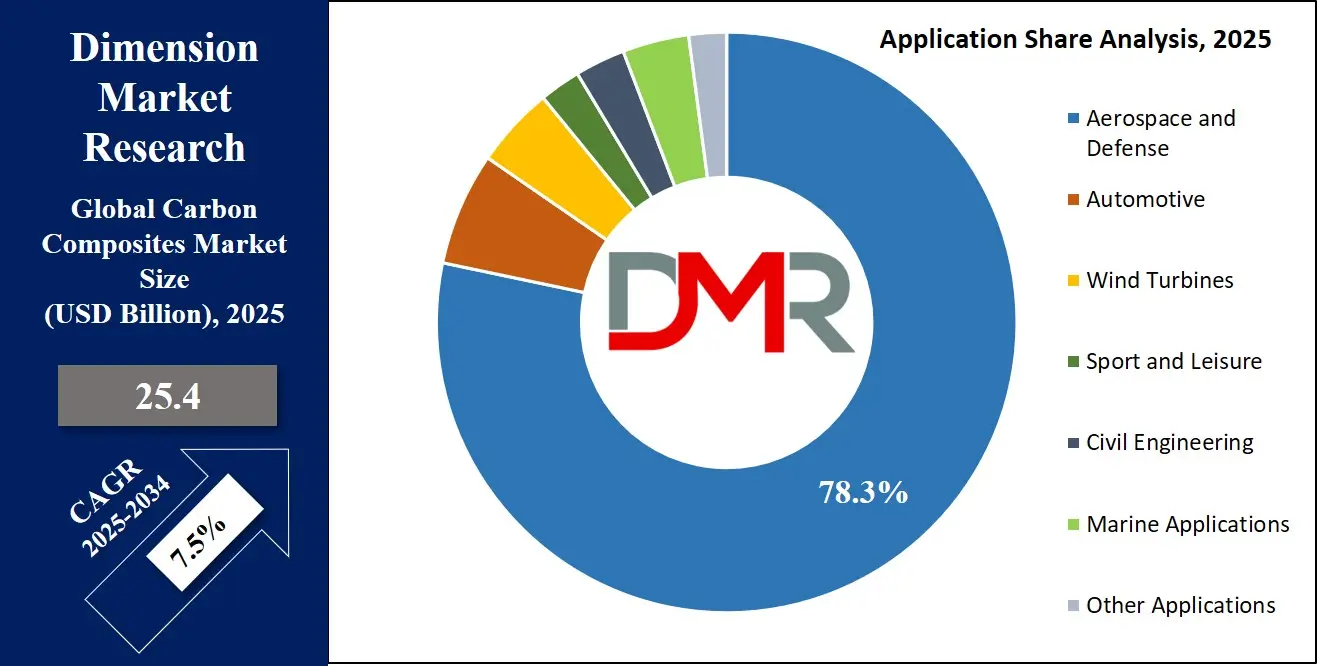
The Carbon Composites Market Report is segmented on the basis of the following:
By Matrix
- Polymer
- Hybrid
- Metal
- Ceramic
- Carbon
By Process
- Prepreg Layup Process
- Pultrusion and Winding
- Wet Lamination and Infusion Process
- Press and Injection Processes
- Other Processes
By Application
- Aerospace and Defense
- Automotive
- Wind Turbines
- Sport and Leisure
- Civil Engineering
- Marine Applications
- Other Applications
Regional Analysis
Region with the largest Share
North America is predicted to dominate the global carbon composites market with a 36.3% revenue share by the end of 2025, due to its robust aerospace, defense, and automotive industries, which demand lightweight and high-strength materials. The increasing adoption of carbon composites in electric vehicles and wind energy further fuels market expansion.
Additionally, stringent environmental regulations and sustainability goals drive innovation in eco-friendly composite materials. Significant investments in research and development, coupled with the presence of key industry players, enhance market growth. The U.S. leads the region, supported by a strong supply chain, advanced manufacturing capabilities, and government initiatives promoting carbon composite applications.
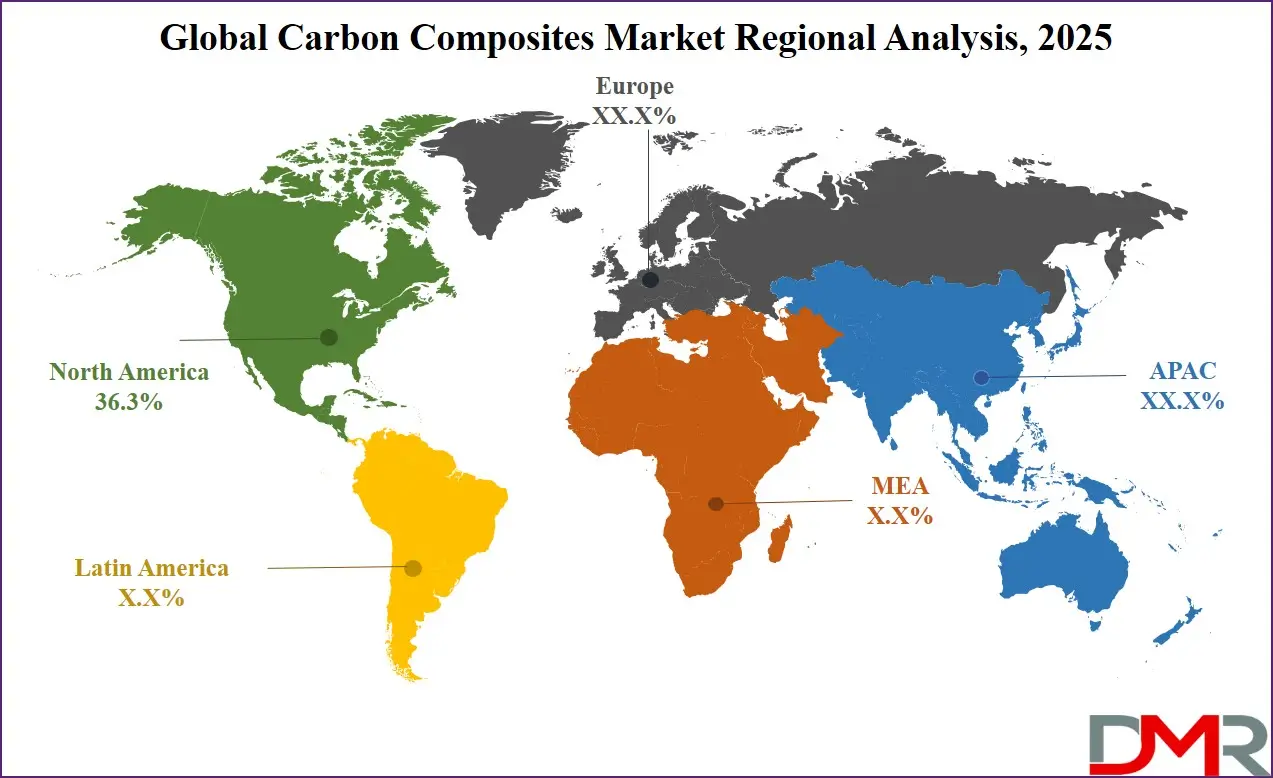
Region with Highest CAGR
Europe is expected to experience high growth in the carbon composites market due to its strong aerospace sector, increasing production of lightweight electric vehicles, and a focus on sustainable manufacturing. Stringent environmental regulations push industries to adopt eco-friendly materials, accelerating demand for carbon composites. Government policies supporting renewable energy, particularly wind power, further contribute to market expansion.
Germany leads the region due to its advanced automotive and aerospace industries, while the UK is the fastest-growing market, driven by innovation and investments in green technologies. The shift towards circular economy principles also fosters the adoption of recyclable composite materials.
By Region
North America
Europe
- Germany
- The U.K.
- France
- Italy
- Russia
- Spain
- Benelux
- Nordic
- Rest of Europe
Asia-Pacific
- China
- Japan
- South Korea
- India
- ANZ
- ASEAN
- Rest of Asia-Pacific
Latin America
- Brazil
- Mexico
- Argentina
- Colombia
- Rest of Latin America
Middle East & Africa
- Saudi Arabia
- UAE
- South Africa
- Israel
- Egypt
- Rest of MEA
Competitive Landscape
The global carbon composites market is highly competitive, driven by innovation, sustainability, and strategic partnerships. Leading players such as Toray Industries, Teijin Limited, Mitsubishi Chemical Holdings, Hexcel Corporation, Solvay S.A., and SGL Carbon SE dominate the landscape. Toray leverages vertical integration and acquisitions, notably its purchase of Zoltek, to expand its product offerings and global footprint. Teijin focuses on sustainability, introducing green carbon fiber derived from recycled and bio-based materials.
Mitsubishi Chemical emphasizes diversification and innovation, recently developing a ceramic matrix composite capable of withstanding extreme temperatures for aerospace use. Hexcel Corporation strengthens its position through aerospace collaborations and manufacturing expansion, while Solvay continues to innovate with advanced prepreg materials for cost-effective, high-performance applications. SGL Carbon SE stands out with its global production and service network, supporting various industries through advanced carbon solutions.
The market is further shaped by companies like Northrop Grumman, 3M, and GKN Aerospace, who contribute through niche innovations and application-specific solutions. The increasing demand for lightweight, durable, and eco-friendly materials in aerospace, automotive, and industrial sectors continues to push competitors toward sustainable and high-performance innovations. As a result, the competitive landscape is dynamic, with companies focusing on R&D, strategic alliances, and global expansion to maintain their market edge.
Some of the prominent players in the Global Carbon Composites Market are:
- Solvay
- Nippon Carbon Co Ltd.
- TORAY INDUSTRIES INC.
- Teijin Aramid BV
- Mitsubishi Chemical Holdings Corporation.
- Carbon Composites Inc.
- SGL Carbon
- Hexcel Corporation
- China Composites Group Corporation Ltd
- Rockman
- Epsilon Composite
- Plasan Carbon Composites
- Hyosung Advanced Materials
- Zhongfu Shenying Carbon Co. Ltd.
- Kureha Corporation
- DowAksa
- Jilin Chemical Fiber Group Co. Ltd.
- Jiangsu Hengshen Co. Ltd.
- Anshan Sinoda Carbon Fibers Co. Ltd.
- China National Bluestar (Group) Co. Ltd.
- Other Key Players
Recent Developments
- In June 2023, Solvay and Spirit Aero Systems strengthened their partnership in research and technology to advance the development of composite aero structures. Their collaboration focuses on innovating manufacturing techniques and improving automation and assembly processes to reduce risks and shorten development timelines. They also plan to explore broader strategic innovation opportunities together.
- In April 2023, Solvay extended its existing partnership with GKN Aerospace, which began in 2017. The renewed agreement includes a joint roadmap for thermoplastic composites (TPC), aimed at discovering new materials and production methods for aerospace applications. Both companies are also aligning their efforts toward future high-rate production programs, with Solvay continuing as GKN Aerospace’s preferred supplier for TPC materials.
- In March 2023, Solvay and Airborne secured funding to develop a composite-based alternative to traditional metal battery enclosures. Airborne, known for its expertise in automated and digitalized composite manufacturing, has teamed up with Solvay on this project, which has received support from Jaguar Land Rover and Vertical Aerospace. The project aims to create more compact, lightweight battery enclosures for electric vehicles and aircraft, with an emphasis on sustainability through the reuse of composite waste.
- In November 2022, Celanese Corporation finalized its acquisition of the majority of DuPont's Mobility & Materials (M&M) business. This acquisition includes a diverse range of engineered thermoplastics and elastomers, prominent brands, intellectual property, global manufacturing capabilities, and a highly skilled workforce.
- In September 2022, Mitsubishi Chemical Group Corporation partnered with the Japan Windsurfing Association to support recycling initiatives focused on carbon fiber used in windsurfing gear.
Report Details
| Report Characteristics |
| Market Size (2025) |
USD 25.4 Bn |
| Forecast Value (2034) |
USD 48.6 Bn |
| CAGR (2025–2034) |
7.5% |
| Historical Data |
2019 – 2024 |
| The US Market Size (2025) |
USD 7.8 Bn |
| Forecast Data |
2025 – 2033 |
| Base Year |
2024 |
| Estimate Year |
2025 |
| Report Coverage |
Market Revenue Estimation, Market Dynamics, Competitive Landscape, Growth Factors, etc. |
| Segments Covered |
By Matrix (Polymer, Hybrid, Metal, Ceramic, and Carbon), By Process (Prepreg Layup Process, Pultrusion and Winding, Wet Lamination and Infusion Process, Press and Injection Processes, and Other Processes), By Application (Aerospace and Defense, Automotive, Wind Turbines, Sport and Leisure, Civil Engineering, Marine Applications, and Other Applications) |
| Regional Coverage |
North America – US, Canada; Europe – Germany, UK, France, Russia, Spain, Italy, Benelux, Nordic, Rest of Europe; Asia-Pacific – China, Japan, South Korea, India, ANZ, ASEAN, Rest of APAC; Latin America – Brazil, Mexico, Argentina, Colombia, Rest of Latin America; Middle East & Africa – Saudi Arabia, UAE, South Africa, Turkey, Egypt, Israel, Rest of MEA |
| Prominent Players |
Solvay, Nippon Carbon Co Ltd., TORAY INDUSTRIES INC., Teijin Aramid BV, Mitsubishi Chemical Holdings Corporation., Carbon Composites Inc., SGL Carbon, Hexcel Corporation, China Composites Group Corporation Ltd., Rockman, Epsilon Composite, Plasan Carbon Composites, Hyosung Advanced Materials, Zhongfu Shenying Carbon Co. Ltd., Kureha Corporation, DowAksa, Jilin Chemical Fiber Group Co. Ltd., Jiangsu Hengshen Co. Ltd., Anshan Sinoda Carbon Fibers Co. Ltd., China National Bluestar (Group) Co. Ltd. , and Other Key Players |
| Purchase Options |
We have three licenses to opt for: Single User License (Limited to 1 user), Multi-User License (Up to 5 Users), and Corporate Use License (Unlimited User) along with free report customization equivalent to 0 analyst working days, 3 analysts working days, and 5 analysts working days respectively. |
Frequently Asked Questions
The Global Carbon Composite Market size is estimated to have a value of USD 25.4 billion in 2025 and is expected to reach USD 48.6 billion by the end of 2034.
North America is expected to be the largest market share for the Global Carbon Composite Market with a share of about 36.3% in 2025.
Some of the major key players in the Global Carbon Composites Market are Hexcel Corporation, Toray Industries Inc., Toray Industries Inc., and many others.
The market is growing at a CAGR of 7.5 percent over the forecasted period.
The US Carbon Composite Market size is estimated to have a value of USD 7.8 billion in 2025 and is expected to reach USD 14.3 billion by the end of 2034.